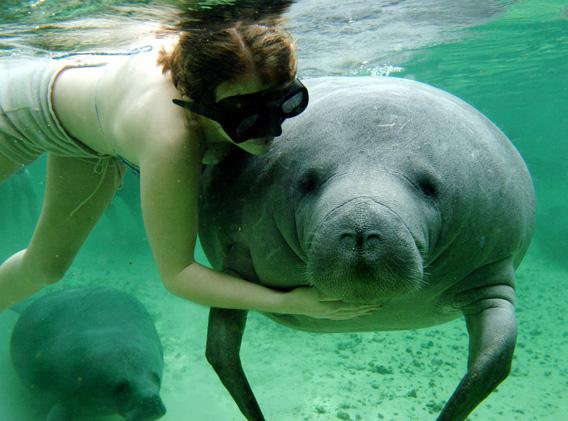Last year, a woman at a Florida beach spotted a manatee swimming past and jumped on its back like it was a horse. Other beachgoers shouted at her to stop, but she paid them no heed. She was riding a manatee! What a feeling! Woo-hoo!
Someone snapped photos of her and turned them in to the Pinellas County Sheriff’s Office. The cops distributed the photo at a press conference, asking for help identifying the woman because she was breaking the law. The manatee-rider’s picture wound up appearing on computer screens around the globe thanks to aggregation sites that found it hilarious that Florida would have a law against riding manatees. Oh, those wacky folks in Florida! Never mind that manatees are an endangered species, and so federal law forbids harassing or molesting them too. (The manatee-rider was eventually arrested and wound up in a pretrial intervention program.)
Florida’s animal population is part of what makes it so special. We’ve got animals found no place else. But a lot of people in Florida—tourists and residents alike—can’t just watch a wild animal being wild. They want to be more than passive observers. They have to put themselves into the picture, make themselves the star of this nature show. Hey, it’s a baby manatee! Put the kids on its back and post the photos to Facebook! Yeeeee-haw!
All around the Florida coast are well-meaning waterfront homeowners who stand on their docks and use a hose to spray water into the mouths of manatees. They think they are doing something nice for the manatees. Hey kids, come see this wonderful thing! These folks never consider whether it’s wise to get manatees in the habit of congregating around docks where they might be clobbered and killed by boats, the leading human-related cause of death among sea cows.
What’s true on the water is true on land. In the Florida Keys is a colony of about 700 deer the size of big dogs. This species, like the manatee, has been on the endangered list since 1967. The Key deer are so cute that tourists driving through the National Key Deer Refuge can’t resist rolling down their windows and offering them treats—which means the Key deer now associate cars with food. As a result, the leading cause of death for Key deer is being run over. There are other ramifications, too—witness the recent story about the Key deer that got its head stuck in a Doritos bag.
For decades, Florida’s roadside attractions have employed animals as a prop to draw in the paying customers. Airboat tour captains showing off the Everglades have been known to toss food in the water to attract alligators. It’s just not a trip through the River of Grass without them, right? It seems like a harmless practice until somebody loses a hand.
The most misunderstood animals in Florida are the dolphins. People see that famous dolphin smile and think the dolphin is always friendly, always eager to please a human. That’s not good for either the dolphins or the humans.
Last year, Sarasota County marine patrol deputies found the carcass of Florida’s most famous dolphin since Flipper stopped chirping for the TV cameras. The dead dolphin’s name was Beggar, and for 20 years that was his claim to fame.
All you had to do is rap on the side of your boat and Beggar would swim up and thrust a smiling snout out of the water to beg for food. Pictures and videos of Beggar circulated widely on the Internet—jumping, snatching a tossed fish from the air, shooting through the water in hot pursuit of a speeding boat. People fed him more than just fish—they tossed him potato chips, macadamia nuts, oranges, apples.
The dead dolphin’s digestive tract contained fish hooks and squid beaks—neither the normal diet for a bottlenose. Beggar was underweight and dehydrated. Biologists are convinced Beggar was killed by all the people who claimed to be fans. He was loved to death.
Beggar was not an isolated case. Some dolphins have grown so accustomed to getting their food from humans that they will steal bait right off fishing lines—which has so enraged some anglers and boat captains that they have gone bonkers trying to chase them away, firing guns or even tossing pipe bombs at the dolphins.
Just as Beggar got in the habit of taking handouts, people have been conditioned to think that dolphins are friendly. We’ve seen the dolphins at SeaWorld leaping on command and being tossed their rewards by human handlers. We’ve ridden on the see-the-dolphin cruises. Maybe we’ve even gone swimming with the dolphins. We think we know what dolphins want. They’re like pets. You can pat them on the head like a dog and everything’s fine. …
Until the dolphins’ teeth clamp down on your hand, that is.
“In Beggar’s defense,” a biologist told me, “he only used the teeth when people weren’t feeding him.”
For some reason we just find it hard to believe that any animal might not be an apt accessory to our Florida lifestyle—until they do something to remind us that they’re wild animals, like escaping to wreak havoc or attacking a child. I once spent a day hanging out with some wildlife inspectors at the Miami airport, where they have found marmosets hidden under a man’s hat, Cuban parrot chicks tucked in a woman’s bra (one per cup), and 45 red-footed tortoises stuffed in a man’s parachute pants. While I was there, a dude walked up to the intake window and casually told the woman on duty, “Hey. I just bought a tiger off a guy and it didn’t come with any papers and I wondered if that’s a problem.”
“Well sir,” she said, frowning, “first let’s think about where tigers normally live, OK? It’s not Florida.”
